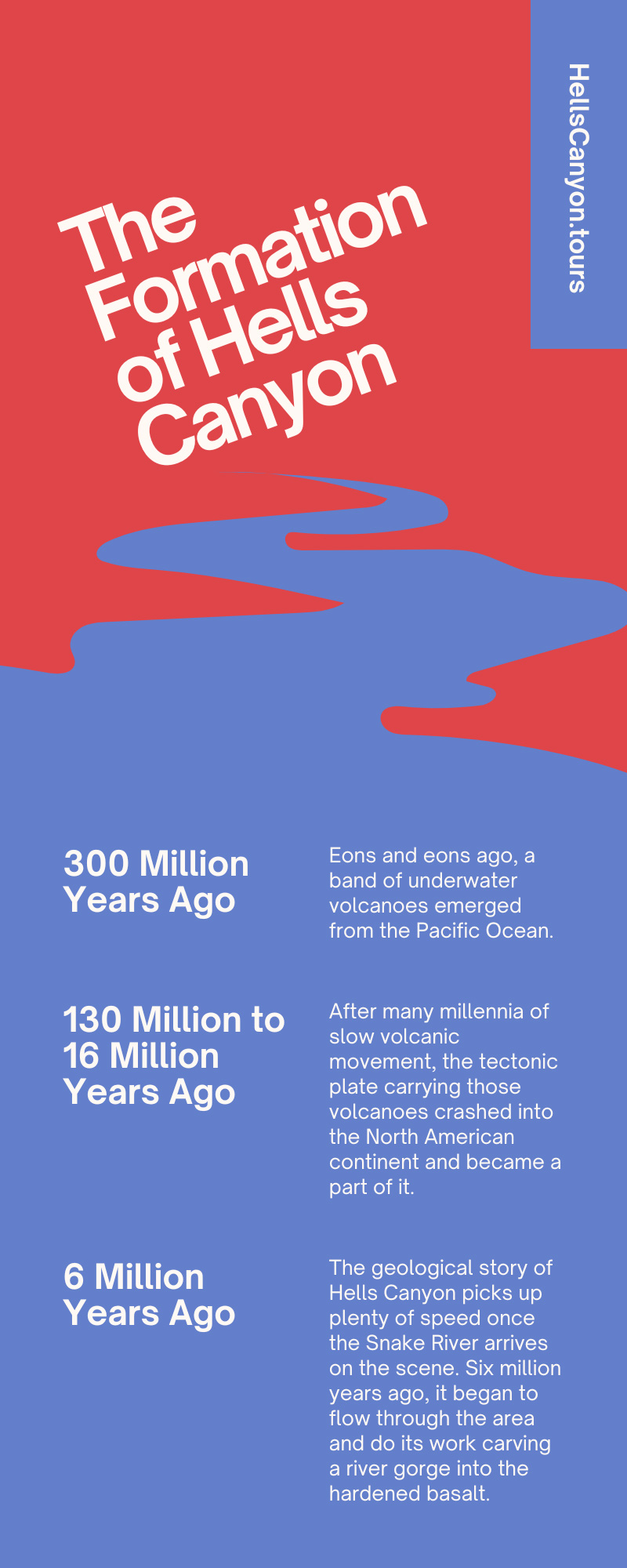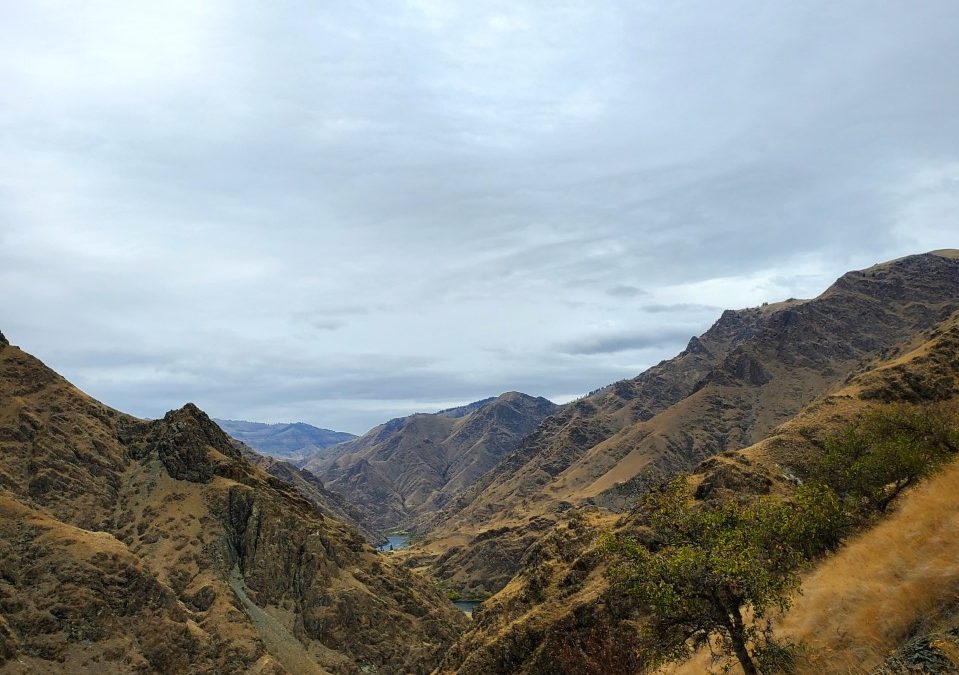How did Hells Canyon get to be the way it is today, anyway?
The story of Hells Canyon begins millions of years ago, as volcanic activity and tectonic shift carved out the basic shape of the canyon you see today. Humans have settled in the area for thousands of years, contributing to the rich natural and anthropological history you see around you. When you take a boat tour with River Adventures, your tour guide will share more of the unique history of the area.
Let’s learn more about the deepest river gorge in North America: its history, natural features, and how you can enjoy the Hells Canyon area today.
The Formation of Hells Canyon
To truly get the whole history of Hells Canyon, we’ll have to go back in time—pretty far back, as a matter of fact.
300 Million Years Ago
Eons and eons ago, a band of underwater volcanoes emerged from the Pacific Ocean. Despite their explosive potential, volcanoes move remarkably slowly; over the next several million years, they settled and subsided around what is now Hells Canyon. The movement of tectonic plates around these volcanoes affected their shape and location.
The occasional lava flows from those volcanoes spread around the area and hardened into basalt. Under the surface of the water, limestone built up and hardened.
130 Million to 16 Million Years Ago
After many millennia of slow volcanic movement, the tectonic plate carrying those volcanoes crashed into the North American continent and became a part of it. This movement triggered more volcanic activity, covering the area with even more basaltic lava flows. At this point, Hells Canyon was more of a high plateau than a canyon of any sort!
6 Million Years Ago
The geological story of Hells Canyon picks up plenty of speed once the Snake River arrives on the scene. Six million years ago, it began to flow through the area and do its work carving a river gorge into the hardened basalt. When you visit us for the best Hells Canyon jet boat tours around, you’ll see six million years’ worth of the Snake River’s hard work on the canyon walls.
Early Human Settlements
The first humans known to have inhabited Hells Canyon are the Nez Perce tribe, also known as the Niimiipuu. They have lived on and stewarded this land for thousands of years, along with the Paiute and Shoshone tribes.
Indigenous Americans were attracted to Hells Canyon due to its biodiversity. There were, and still are, many different species of animals to hunt and plants to gather to create a balanced diet. They enjoyed the relatively mild winters and balmy weather that we still enjoy today.
Pictographs (paintings) and petroglyphs (rock carvings) from Hells Canyon’s earliest human inhabitants still survive on the canyon walls to this day.
Westward Explorers
In 1806, three members of the famous Lewis and Clark expedition made their way to the Hells Canyon area by following the Salmon River. However, they turned back before they were able to see the full width and depth of the canyon.
Five years later, in 1811, the Wilson Price Hunt expedition ventured further into Hells Canyon as they sought a shortcut to the Columbia River. They saw more of the canyon than Lewis and Clark’s compatriots did, but they were not prepared for the cold weather. In addition, they realized upon seeing the canyon’s sheer size and depth that they had not brought enough food to continue on, so they turned back.
The next explorers in the Hells Canyon area were drawn in by gold. In the 1860s, small gold deposits were found near what is now the Hells Canyon National Recreational Area. However, the gold deposits in nearby river bars proved too scant to be profitable. Physical evidence of gold mining remains along the walls of the Snake River.
In the 1880s, would-be homesteaders flocked to the area in attempts to establish family farms and ranches. This boom, much like the gold rush, would prove short-lived. The farming and ranching techniques these settlers used were not fruitful, as they were unfamiliar with the land and the weather. If you visit the Hells Canyon National Recreation Area, however, you will see a few ranches still in operation today.
By the 1890s, the canyon was known to settlers and explorers as either Box Canyon or Snake River Canyon. In 1895, though, an explorer known only as Norma wrote a piece for a publication called McCurdy’s Marine History of the Pacific Northwest. She describes a steamboat that “bound off, swinging into midstream, and like a racehorse, shot into Hells Canyon.” This is the first recorded use of the name we use for this majestic river gorge today.
Building Dams for the Snake River
In the first half of the 20th century, several dams were built on the Columbia River to provide hydropower to the area. Inhabitants of the Hells Canyon area wanted to do the same for the Snake River, so they sought help from the Federal Power Commission to build three dams:
- Brownlee Dam, the first of the three, finished construction in 1960.
- Oxbow Dam was completed 12 miles downstream in 1972.
- Hells Canyon Dam, 26 miles beyond Oxbow, was finished in 1987.
These three dams, working in sync, provide up to 70 percent of Idaho’s water-powered electricity. While two other dams were proposed to add to this system, that project fizzled in 1975 when then-President Gerald Ford designated the Hells Canyon National Recreation Area.
Present-Day Recreation
Ever since Ford put the Hells Canyon National Recreation Area in place, the canyon has been an exciting wilderness destination. Whether you want to raft, swim, hike, fish, or simply enjoy the nature around you, the Hells Canyon area has been expertly preserved and cared for.
Thanks to the conservation efforts of organizations like the Idaho Department of Fish and Game, the Hells Canyon environment still offers what early settlements loved about it. From the bounty of fish in the Snake River to the diverse wild animals and plants on land, the canyon is a haven for nature lovers from all over.
Book a trip to Hells Canyon with your loved ones and see everything the deepest river gorge in North America has to offer. From its rich history to the plethora of activities you can enjoy, Hells Canyon makes a perfect destination.


Recent Comments